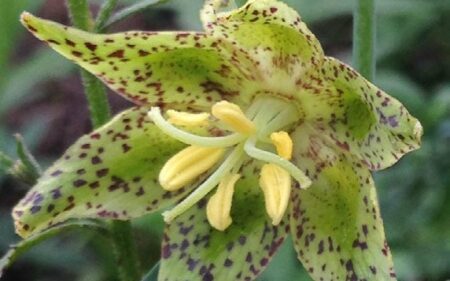From Seed to Specimen
The Santa Barbara Botanic Garden is a living collection of California’s native plants and an accredited museum – one of 57 public gardens that currently hold accreditation through the American Alliance of Museums.* Most of the plants you encounter on our grounds have roots in the wild, being directly collected by garden staff who explore across the state to seek them out. They often spend days backpacking and camping, looking for handfuls of seed or cuttings that need to be stored in a cooler to keep them fresh for propagating. With each collection, notes are taken that will be transcribed into the plant records database once the seeds and cuttings make it back to the Garden.

The first stop for new plant material at the Garden is meticulous documentation with the Living Collections Coordinator, Betsy Lape. Betsy takes the plants through a process in museum terms called accessioning, where the new item receives a unique number. Each accession is a new record with stacked layers of metadata describing it, when and by whom a plant was collected, notes about the habitat, and other plants where the parent population was growing. Over the lifetime of the plant, more layers are added and it is these layers of data that give the collection a true purpose. We can use this data to generate stories for interpretive themes, to allow educators to use the Garden as an outdoor classroom, for these plants to be representatives of their wild cousins in the Garden’s research projects, and to enable the plants from the Garden to be founders for reintroductions that save species from extinction.

Once assigned an accession number, collected seeds will move to the Living Collections Nursery, where they will germinate and grow to an appropriate planting size. “One of the biggest challenges in the nursery is that there is a lack of published knowledge on how to grow many of these plants. We might be the first people growing them in a nursery and garden,” says Jessica Fernandez, the Garden’s Propagator. The Garden has a history of expertise in leading and publishing plant propagation methods for California native plants that we aim to continue. In the nursery, more layers of data are added to the records for reference the next time we need to grow that species. and as the plant grows, ongoing inventory notes are compiled on the planting’s condition. We note any observed diseases, and sometimes even finer details like the sex of the plant are documented. The team of gardeners who tend the Garden make up our museum conservators, ensuring that each accessioned plant of the living collection receives the best care the Garden can offer through daily horticultural care; watering, weeding, and pruning the plants. “Caring for the Garden is rewarding because we are creating a beautiful space for visitors and our members, but we also are sharing and preserving a part of California’s natural history that most people would not otherwise have a chance to experience,” says Gardener, Julian Lavelle. Julian tends the Island View Garden that holds plants from all eight Channel Islands and Baja California.


The Garden has maintained accession records since 1934, just eight years after the first garden plantings in 1926. Without complete records, some of our earliest history is somewhat vague. For example, the planting of the iconic Redwood Section with the now towering coastal redwoods (Sequoia sempervirens) began sometime in 1926 or 1927 with more trees added in the early 1930’s – but we aren’t certain which trees were first. We do know that some of the oldest plants at the Garden with definitive birthdays date back to 1935: two California fan palms (Washingtonia filfera) planted in the Desert Section with roots in the Coachella Valley, and a bigcone Douglas-fir (Pseudotsuga macrocarpa) at the south end of the Manzanita Section from a collection at Mt. Wilson in the Sierra Madre Mountains. At 86 years old, these noble giants are maintaining good health and will likely remain a part of the collection well past their centennial. But even when components of the living collection near the end of their lives, the story does not stop. Many accessions will return to the nursery and live on through cuttings, divisions, or grafts, maintaining their contribution to the living collection as the next generation of plants that strike roots.
*Accreditation through this organization showcases the Garden’s commitment to maintaining a standard of excellence in education, public service, and collections care. This requires collaboration among much of the Garden’s staff.




 Donate
Donate




